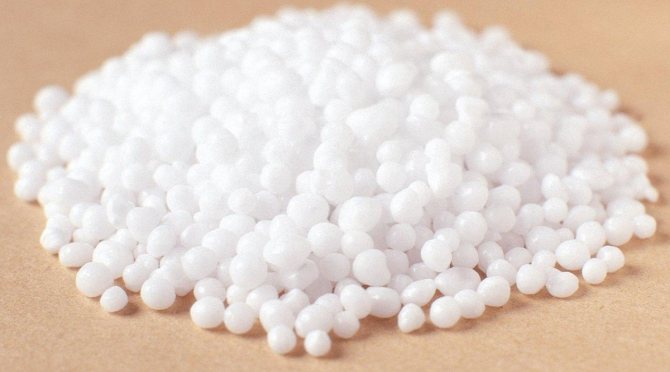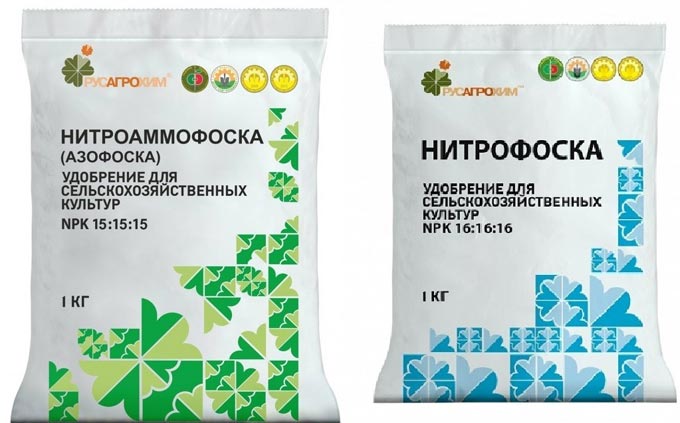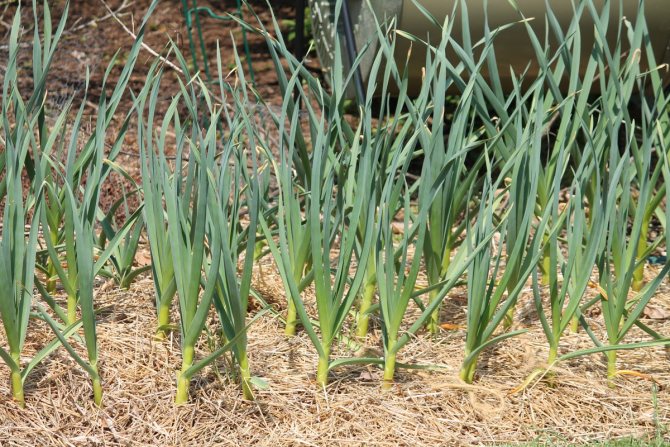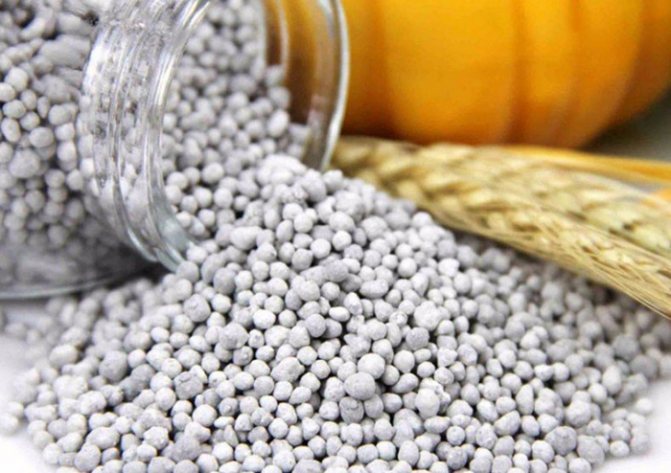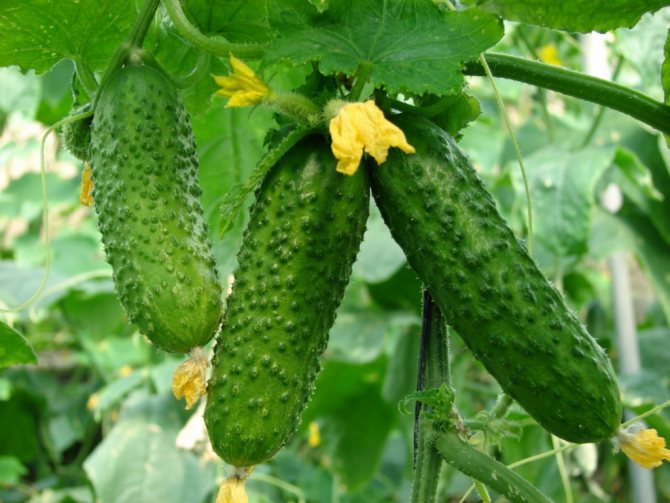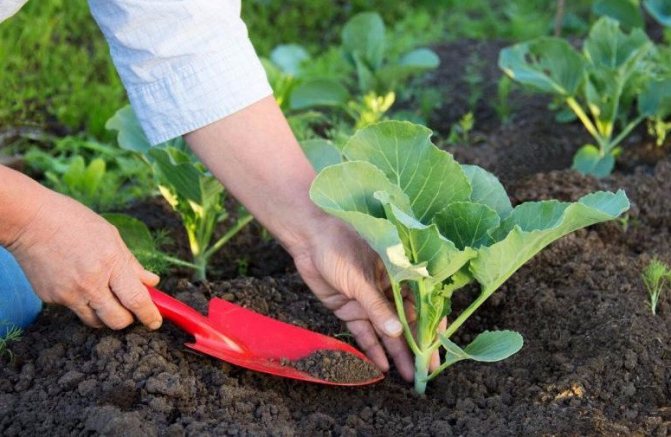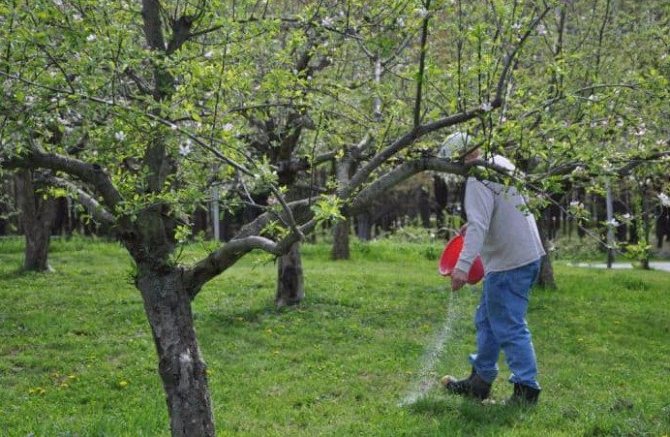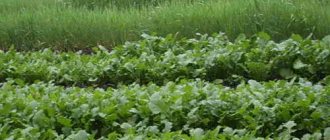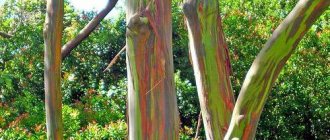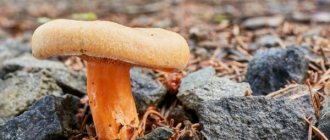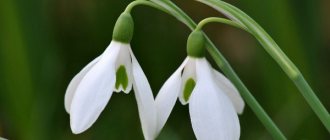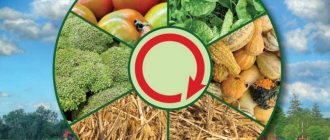Category: Mineral fertilizers Read: 8 min Views: 543
Nitrofoska is a well-known and frequently used nitrogen-phosphorus-potassium mineral fertilizer. The tool is a perfectly balanced, complex agrochemical (agrotuk), which is suitable for application to / in any soil composition. Used for garden plants, orchard, ornamental plantings and indoor flowers.
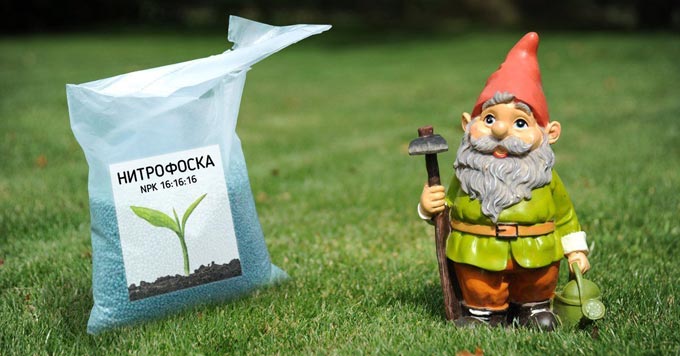
Combining in its composition three fundamental components N (nitrogen) -F (phosphorus) -K (potassium), nitrophoska freely penetrates into all life support systems of plants, mobilizing the redox potential of cell growth and development, activates the processes of photosynthesis, and productively increases the vegetative mass. Regular application of top dressing in the form of Nitrofoska will avoid soil degradation and ensure its constant fruitful potential.
General information on fertilization
Nitrofoska has been used very often and for quite a long time both in large farms and by gardeners and gardeners in small house plots, and the demand for this fertilizer does not decrease.
Nitrophoska is obtained by oxidation of phosphorites or apatites with the introduction of minerals into the composition. The appearance of the fertilizer is light-colored granules that do not disintegrate or stick together under proper storage conditions. Usually nitrophosphate is added to the soil in spring or autumn, fertilizer is often added to the planting pits and holes, and in dissolved form - during the growing season of plants.
It is interesting that both short and long periods of action are characteristic of nitrophoska. For example, potassium and nitrogen contained in the fertilizer become available to plants after a couple of days after fertilizing the soil, and phosphorus turns into available later - after 11-13 days.
The concept of the drug and its composition
To successfully grow plants and get a good harvest, it is necessary that the soil is saturated with nitrogen, potassium and phosphorus. It is these three important components that constitute the formula of the drug.
Due to such a universal composition, it is not necessary to add other expensive fertilizers to the soil.
Nitrogen, phosphorus and potassium help to grow healthy seedlings, form the stem and leaves correctly, promote the setting of flower buds and the formation of large fruits.
Nitrophoska can be used to grow any plant, in any climate and in any soil composition.
As part of the drug, these three useful components are presented in the form of the following salt compounds (the formula of the drug is rather complex):
- Calcium chloride.
- Ammonium nitrate.
- Ammophos.
- Ammonium chloride.
- Precipitate.
- Potassium nitrate.
- Superphosphates.
In addition, the composition also contains gypsum flour and ballast components.
The name of the drug shows that it contains nitrates, which are undesirable for growing plants. Many experts believe that this can harm human health. Nitrofoska is absolutely safe if the drug is used correctly, following the instructions for use.
What is included in nitrophoska?
The main elements of this fertilizer are N (nitrogen), K (potassium) and P (phosphorus).In the fertilizer, they are present in the form of salts, as for their amount, it varies quite a lot and is always indicated on the package.
To use nitrophoska in dry form, we advise you to purchase a fertilizer, in which all three substances are in equal proportions, say, 16:16:16. If you plan to use the fertilizer in dissolved form, then look for a nitrophoska, which also contains magnesium and the ratio of substances is as follows: nitrogen - 15, phosphorus - 10, potassium - 15 and magnesium - 2.
When buying nitrophoska, always carefully read what is written on the package, because there are also compounds on sale in which potassium chloride is present.
Usually you can find three options for this fertilizer (perhaps more, but other options are rare) - these are phosphorite nitrophoska (or superphosphate), sulfuric nitrophoska and sulfate nitrophoska.
For deposit phosphorite nitrophosphate tomatoes respond well, the quality and taste of the fruit improves. The thing is that due to a sufficient amount of phosphorus in the soil, tomatoes lay more fiber in the fruits, and therefore the fruits themselves become denser, juicy, tasty, suitable for transportation and longer storage.
Due to the introduction into the soil sulfuric nitrophosphate vegetable proteins are formed, so this type of nitrophoska is more appropriate to use on soils that are planned to be occupied with beans, beans, peas, and also cabbage. Of course, this type of nitrophoska will have a positive effect on both tomatoes and cucumbers.
Sulphated nitrophoska contains calcium. This type of nitrophoska is more suitable for ornamental plants, improving their appearance, enhancing the color of flowers and leaf blades. This composition of nitrophoska is successfully used for all, without exception, flower plants, ornamental trees and shrubs.
What types of substances are there?
Check out these articles as well
- Growth stimulator Heteroauxin
- How to grow a walnut
- Herbicide Stomp
- What is lemon balm
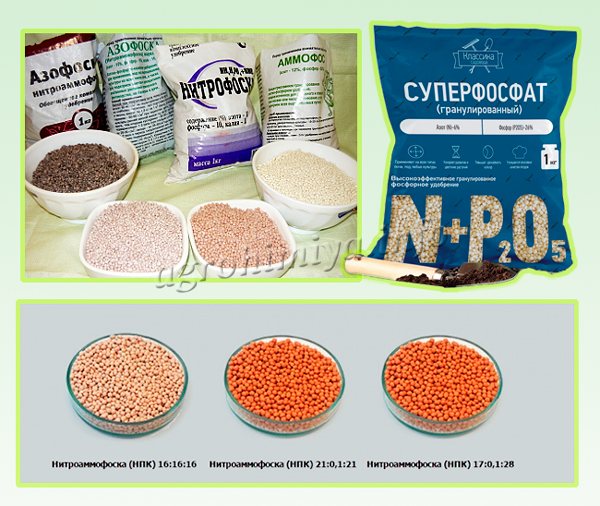

Varieties of fertilizer Nitrofoska
There are three types of nitrophoska, each of which has its own indications for use.
- Nitrophoska superphosphate (phosphate rock) is usually used to improve the quality and condition of tomatoes. Phosphorus in its composition contributes to the formation of fiber.
- Nitrophoska sulfate contains a large amount of potassium, which has a positive effect on the appearance of the plant: the development of buds, inflorescences, leaves. Therefore, it is most often used for growing flowers, ornamental trees and shrubs.
- Nitrophoska sulfate provokes the formation of plant proteins. And, of course, it is more often used for feeding legumes and cabbage, less often for cucumbers and tomatoes.
Dosages of nitrophoska
It is necessary to clearly understand that only the correct dosage of any fertilizer will have a positive effect on plants and will not harm the human body. As you know, there are no absolutely safe substances, even excessive doses of organic matter can adversely affect plants and human health.
So, the dosage of nitrophoska for fruit crops should not exceed 250 g per hole, for small berry bushes (gooseberries, currants) - no more than 90 g per planting hole, for large shrubs (irga, chokeberry, viburnum) - no more than 150 g per fossa.
For adult ornamental tree species (maples and the like), you can apply up to 500 g for each, after loosening and watering the soil of the near-trunk strip. Nitrophoska can also be used for application under plants growing in closed ground, where their number should not exceed 130 g per square meter.
In open ground for vegetable crops, the dosage should be even less - no more than 70 g per square meter. Finally, indoor plants - it is advisable to fertilize them with nitrophos by spraying with a solution consisting of 50 g of fertilizer per bucket of water.
Methods and rates for applying nitrophoska
Nitrofoska can be used on the site in three ways:
- Dry application for digging. Performs before sowing or after harvesting plant residues. The granules are spread evenly and embedded in half of the shovel bayonet.
- Dry application to planting pits and holes. Performed in the spring. The granules are embedded below the root zone, mixing with the soil to avoid chemical burns to the roots.
- Liquid root dressing. Given to actively growing plants. Granules dissolve in irrigation water in a watering can or in a container of drip irrigation systems.
The consumption rates of nitrophoska depend on the individual needs of the crops and on their sensitivity to nitrates:
Nitrophoska increases the yield of garden strawberries, but it must be applied in small doses - no more than 5 g per bush when planting or at the beginning of the growing season.
- Tomatoes, peppers and eggplants are fed when the seedlings are planted. 15 g of nitrophosphate is embedded in each well. After the beginning of fruiting, liquid feeding is performed with a solution of 50 g of the substance per 10 liters of water. When growing late-ripening varieties of tomatoes and peppers in a greenhouse in late July or early August, you can feed the plants with a solution of 8-12-24-4 grade nitrophoska.
- Cucumbers are fed with a liquid solution when the first flowers appear. In irrigation water, 30 g of the substance is dissolved per 10 liters of water. The solution is applied at the root - 0.5 liters per bush. After the appearance of the ovaries, it is better not to use nitrophosphate.
- Cabbage is fed once when planting seedlings. The granules are mixed with the soil in the planting hole in an amount of 15 g per root.
- Fruit shrubs (raspberries, currants, gooseberries, etc.) are dry-fed in spring. The granules are distributed in the near-trunk circle at the rate of 40 g per 1 m 2 and embedded to a depth of 7-10 cm. After that, the shrubs are watered. The second feeding is done after the appearance of the ovaries with a solution of 40 g of nitrophoska per 10 liters of water - 1 bucket at the root.
- Fruit and ornamental trees are fed similarly to fruit shrubs. The granules must be distributed over the entire area of the crown projection. The consumption of liquid top dressing is 3 buckets at the root.
When planting seedlings, nitrophoska is added to the soil mixture only in spring. For each seedling, 30 g of nitrophoska is consumed. It is better not to use it in autumn, since it can provoke an unplanned awakening of the buds, the seedling will not take root well and will not overwinter.
Fertilizer packaging and storage
Industrial enterprises pack Nitrofoska either in paper bags or in plastic bags or sacks. This fertilizer should be stored out of reach of sunlight with a humidity of less than 60%.
Important! Nitrofoska belongs to the category of flammable and even explosive substances, so you should choose a storage location that is far from possible hot spots of open fire.
Do not confuse nitrophoska and nitroammophoska, these are different fertilizers with different doses of application. For nitroammophoska, a composition enriched with minerals is characteristic, therefore this fertilizer is more suitable for application under vegetable plants. Doses of nitroammophoska application are almost two times lower.
Varieties of the drug
Mineral components NPK in the classic nitrophoska are contained in equal proportions. This preparation is used exclusively dry. If you plan to apply in a liquid state, then choose a nitrophoska with a magnesium (Mg) content. The fertilizer may contain other trace elements. Based on this, the funds are divided into several categories:
- Sulfuric nitrophoska contains sulfur (S). It is used for cucumbers, tomatoes, cabbage.
- Sulphated nitrophoska with calcium (Ca). Strengthens shoots, makes greens brighter. Suitable for ornamental crops.
- Phosphorite nitrophoska with increased phosphorus content. Helps vegetables synthesize fiber. Fruits, berries and vegetables after its application become stronger and are stored longer.
Benefits of using nitrophoska
Nitrofoska has a balanced composition of mineral components, has three main substances, thanks to which the fertilizer can be used for various crops. The undoubted advantages of nitrophoska include:
- nitrate and pesticide safety (subject to optimal application rates);
- increased efficiency, due to the relatively low price, convenient storage and relatively small doses of application;
- increased ability to dissolve in water, which can be used for fertigation (fertilization with drip irrigation);
- almost complete decomposition in the soil, allowing plants to assimilate the elements in full.
Pros and cons
Compared to other dressings, nitrophoska has the following positive properties:
- Ideal balance of the main components of the fertilizer, which ensures sufficient mineralization of the soil composition and good digestibility by crops.
- The main macronutrients of the fertilizer are well released into the soil and are quickly absorbed and assimilated by the root system of plants.
- Variable variety of application methods - from pouring granules into the wells to applying an agrochemical by drip irrigation.
- Application on any soil is possible.
- Excellent keeping characteristics. The granules are treated with a special condensing coating and therefore, during the entire guaranteed storage period, they remain free-flowing, do not lump and compress.
- Ergonomic and economical use. To ensure adequate plant nutrition, it is enough to add 20-40 grams. top dressing per m2.
- Convenient granular form of release, which greatly simplifies the procedure of use and dissolves easily in water.
- Compliance with a competent and accurate dosing regimen does not lead to the accumulation of nitrates in the soil and vegetation. Ecological purity of the resulting crop.
The disadvantages of this agrochemical include:
- Short shelf life of the fertilizer due to the special volatility of the nitrogen compound.
- Flammability and explosiveness of the chemicals included in the fertilizer.
- Nitrophoska is not effective enough during the ripening of fruits, therefore, additional agro-mixtures are required.
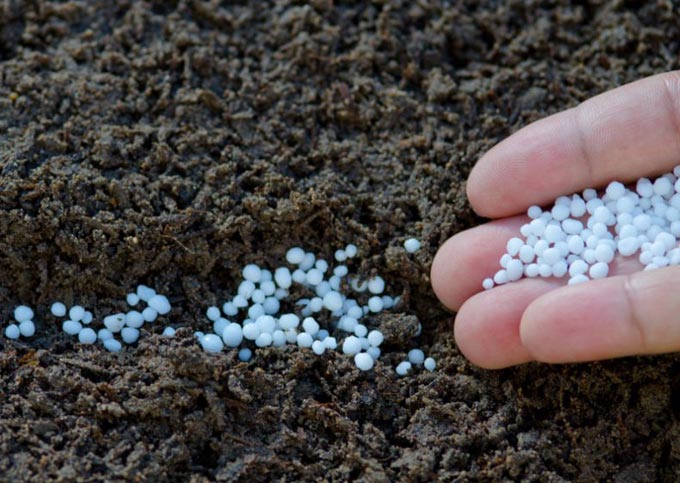

Application of nitrophoska on different types of soils
Nitrophoska is best used on neutral or slightly acidic soils. It is appropriate to apply nitrophosphate on peat, sandy, boggy, and clayey soils. Keep in mind, however, that when applied on sandy soils, the nitrogen component of the fertilizer can be actively washed out, therefore, it is recommended to apply fertilizer on such soils either in the spring (simultaneously with digging the soil), or by adding it to the holes during planting, but not in the autumn period. On peat and clay soils, on the contrary, it is better to apply nitrophosphate in the autumn period.
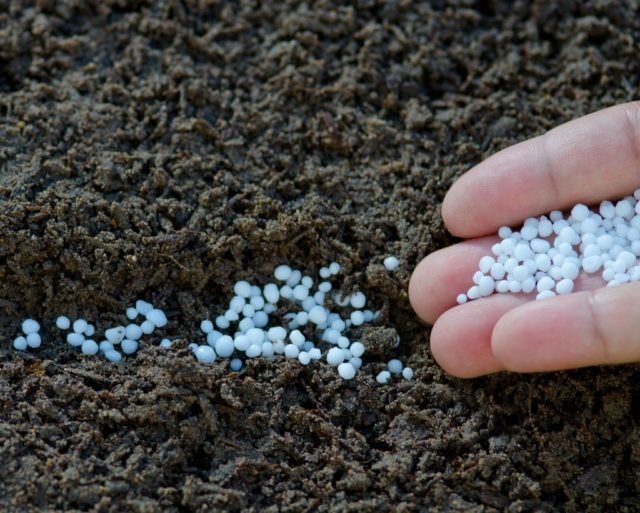

The use of nitrophoska. <>
Precautions


Despite the fact that the instructions for using nitrophoska and other mineral fertilizers are simple, it is important to remember some important points. Compliance with a number of rules can help not to spoil the crop and not poison.
Some people believe that mineral fertilizers increase the amount of nitrates in vegetables. At the same time, it does not occur to anyone that a plant can obtain the same nitrates in another way.It was noticed that grandmothers who use natural manure, the amount of nitric acid salts in garden surplus goes off scale, while tasteless store vegetables fit into the norm for this indicator.
In the application of fertilizers, as in everything else, a measure is needed. Before embedding them in the soil, it is advisable to know as best as possible its composition, at least from previous observations: how crops developed in previous years, what was the yield. The lack of any element is reflected in the growth of culture, any agronomist knows about this.
When it comes to working with fertilizer, care must be taken. You need to work with gloves, wash your hands after the procedure. If it gets into the eye, rinse with water. If nitrophoska gets into food, you should take an emetic, and if the condition worsens, consult a doctor.
Store nitrophosphate in a place inaccessible to children and animals, preferably away from sources of open fire. The room should not be wet: although the granulate is produced quite resistant to getting wet, water, as you know, wears away the stone.
General rules for feeding
There are a number of important rules for making nitrophoska that must be taken into account. For example, when feeding perennial crops, it is better to apply this fertilizer in a dry state, but into the soil that is well loosened and moistened in advance.
It is appropriate to use nitrophoska during rainy periods. When applying nitrophoska in the autumn for digging the soil, in the area where planting of plants is planned in spring, it should not be applied in the spring. And of course, given the nitrogen content in nitrophos, top dressing under perennial plants should be carried out only in the spring, in order to avoid the activation of growth processes and a decrease in winter hardiness.
Features of production
The raw materials for the production of complex fertilizers are air nitrogen, apatite or phosphoric concentrate, potassium salts, hydrogen. Nitrogen under pressure is converted into a liquid state, after which it is mixed with hydrogen at elevated temperatures. This process is energy-intensive, thus getting ammonia. It is used in the future to obtain other intermediate products, primarily nitric acid.
Getting nitrophoska - a whole series of chemical reactions. But the main one is the treatment of apatite with nitric acid:
In addition, a certain amount of Ca (H₂PO₄) ₂ is formed. Calcium nitrate, which is one of the reaction products, is very hygroscopic, and the resulting mixture cannot be stored, it will become damp. Therefore, it is treated with ammonia and sulfuric acid, and sometimes immediately with ammonium sulfate. The resulting ammonium nitrate and gypsum are more resistant to external influences.
Sometimes sulfuric acid is replaced with cheap carbonic acid, in which case calcium carbonate will be a by-product. And if the previous nitrophosphate can be called sulfate or sulfate (depending on what was used - sulfuric acid or its salt), then carbonic acid is obtained through carbonic acid.
Standard phosphoric nitrophoska is obtained by treating the products of the first reaction with phosphoric acid, ammonia and potassium chloride. Monoammonium phosphate and diammonium phosphate, as well as potassium nitrate are obtained.
Chlorine can be excluded from the fertilizer if potassium chloride is pretreated with sulfuric acid. In this case, hydrogen chloride will be released, and the remainder will contain potassium phosphate. Sometimes chlorine removal is a necessary process; it hurts some cultures.
The largest producers of nitrophosphate in Russia are also Akron, and the Khibiny mines have been the main source of phosphorus raw materials for many years. The main consumption falls on the countries of Asia. Granular fertilizer is packed in bags of different sizes.
The use of nitrophoska when growing seedlings
It is appropriate to use nitrophoska when growing seedlings when the plants are poorly developed.It is advisable to feed weak seedlings 5-7 days after the pick. Top dressing should be carried out only with nitrophosphate dissolved in water in an amount of 14-16 g per liter of water, this amount is enough for 45-55 plants.
You can re-feed the underdeveloped seedlings with nitrophosphate at the same time as planting it in the ground, adding literally 10 granules of this fertilizer to each hole, be sure to mix well with moist soil, so that the roots do not touch the granules, otherwise it can lead to burns on the roots, more worsening the condition of the plants.
Instructions for use
Most often, this fertilizer is used in the spring to enrich the soil with useful substances before planting.
The drug is scattered either around the perimeter of the garden, or introduced directly into the hole before planting seedlings or when sowing seeds.
To fertilize shrubs and trees, Nitrofoska is used in autumn.
Indoors, you can also use Nitrofoska for growing vegetables.
Fertilizer application for different crops
Indoors (in greenhouses) - from 40 g to 140 g per 1 sq. m.
Raspberries - apply to loose soil between rows of bushes, fertilizer granules should be slightly deepened 50 g per 1 sq. m.
Roses - put into the holes from which the bushes grow, deepening a little - 10 g for each bush. It is necessary to ensure that the granules of Nitrofoska do not come into contact with the root system.
Cucumbers - when planted, 30 g of the product are poured into each hole, and during the growing season they are watered with a liquid solution at the rate of 4 g per 1 liter of water.
Potatoes - from 3 g to 5 g in each well from which the seedlings grow.
Tomatoes - 1 tbsp. l. in each hole before planting seedlings.
Strawberries and strawberries - from 40 g to 50 g for each plant bush.
Other crops - 7 g per 1 sq. m.
Large fruit trees - up to 600 g of the drug under each tree is introduced into loose soil.
Saplings of fruit trees and bushes of grapes - from 50 g to 300 g in each hole.
Indoor flowers - 4 tbsp. l. Fertilizers are diluted in a bucket of water and water the plants with this agent and spray their leaves.
Features of the use of nitrophoska for horticultural crops
When growing potatoes
Usually, on potatoes, nitrophosphate is applied directly to the holes when planting tubers. You can safely pour a tablespoon (no peas!) Of nitrophosphate into each hole, and then thoroughly mix the fertilizer with the soil.
If you are planting a large number of potato tubers, then for significant time savings, it is better to introduce nitrophoska in the autumn or early spring periods, under the first digging of the soil, in the amount of 75 g per square meter.
When growing cabbage
As we have already specified, it is better to add nitrophosphate sulfate, which promotes the formation of proteins, under the cabbage. The first feeding of cabbage with nitrophos can be carried out during the period of growing seedlings of this culture, for which you can dissolve 9-11 g of fertilizer in a liter of water and feed the seedlings a week after the pick.
You can re-feed the cabbage when planting seedlings, but only if nitrophoska was not applied to this area either in the spring or in the fall. When planting seedlings in a permanent place, you can add a teaspoon of nitrophoska (no peas!) To each hole and mix thoroughly with wet soil.
Sometimes gardeners use a special mixture, which consists of vegetable compost, wood ash and this fertilizer. Usually you need a teaspoon of wood ash and the same amount of nitrophoska per kilogram of compost.
After planting the seedlings, if no fertilizer has been applied to the hole, you can feed the plants with nitrophos after 14-16 days. For these purposes, nitrophosphate is dissolved in water in an amount of 50 g per bucket with the addition of 150 g of wood ash to the resulting composition.It enhances the immunity of plants, helping to increase resistance to various diseases. This amount can be spent on 2-3 square meters of soil, amusing cabbage.
Re-feeding can be done after two weeks and another one after 16-17 days. When carrying out these dressings, the dose of fertilizer should not exceed 25 g per bucket of water, the norm is also for 2-3 square meters of soil under cabbage. When growing early and middle varieties of cabbage, it is not advisable to carry out the third feeding.
Nitrophoska is used for growing cabbage.
When growing cucumbers
Interestingly, nitrophoska is able to increase the yield of cucumber plants by 18-22%. On the introduction of nitrophoska, due to the presence of nitrogen in it, cucumber plants respond to the full development of the vegetative mass. Potassium helps to improve the taste of cucumber plants, and phosphorus, due to the fact that it stimulates the development of fiber, has a beneficial effect on increasing the juiciness and density of the fruit.
Usually nitrophosphate is applied to the area that is planned to be occupied by cucumber plants ahead of time, that is, in the autumn period for digging the soil in an amount of 25 g per square meter. After planting cucumber seedlings on the site, after two to three days, you can fertilize with nitrophosphate dissolved in water, for this you need to dissolve 35 g of fertilizer in a bucket of water and spend 0.5 liters for each plant.
When growing garlic
Garlic (both winter and spring) is fed with nitrophos in the spring. Usually, urea is added first, and after 14-15 days - nitrophosphate. During this period, you can add nitrophoska dissolved in water in an amount of 25 g per bucket of water. About 3.5 liters of this solution are consumed per square meter of soil under the garlic, that is, a bucket of solution goes into about three square meters of soil under the garlic.
When growing raspberries
Considering that raspberries are very demanding on the composition of the soil and respond well to the introduction of complex fertilizers, it should be fed with nitrofos every year in spring. The amount of fertilizer should be 40-45 g per square meter of soil occupied by raspberries. You can feed common raspberries in the spring, as well as immediately after harvesting the entire crop. It is better to introduce nitrophoska under this plant by burying the granules into the soil simultaneously with loosening the soil on raspberries. The use of nitrophoska on raspberries in the autumn period is unacceptable, as well as the introduction of nitrophoska into the holes when planting raspberry seedlings, if planting is carried out in the autumn period.
When growing garden strawberries
It is permissible to apply nitrophoska for garden strawberries in the spring and summer periods. It is allowed to introduce nitrophoska into the holes when planting garden strawberries in August, provided that it is thoroughly mixed with moistened soil. When planting garden strawberries, literally 5-6 fertilizer granules can be added to each hole, mixing them with the ground so that the roots do not touch the granules. The rest of the dressing on garden strawberries should be carried out simultaneously with abundant watering.
When nitrophoska is introduced into the wells during planting, the initial feeding in spring can be omitted, but fertilized during the flowering period, be sure to before the formation of the ovary. The third top dressing can be carried out immediately after harvesting the entire harvest of garden strawberries. The amount of nitrophoska when feeding should be no more than 30 g, which must be dissolved in a bucket of water, this amount is enough for about 20 plants.
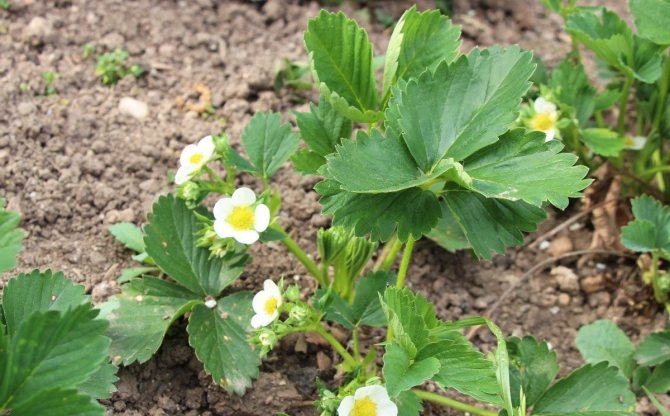

Nitrofoska is the optimal fertilizer for garden strawberries. <>
When growing apple trees
Nitrophoska under an apple tree and other fruit plants are brought in in the spring. It is appropriate to use nitrophoska also at the end of flowering at the beginning of the formation of the ovary.It is permissible to add nitrophoska in a dry form, but if you want to get a quick effect from its introduction, then it is better to pre-dissolve the granules in water in an amount of 45 g per bucket. Under each apple tree, you need to add about three buckets of this solution or 135 g of fertilizer. If the apple trees are over five years old and are grafted onto a vigorous stock, then the dose can be increased to 160 g per plant.
Types of Nitrophoska, additional trace elements
Quantitative indicators of the three basic components of the fertilizer and additional trace elements in it can vary. Depending on the individual needs of plants, the following types of agrochemicals are produced with:
- with a high percentage of sulfur - sulfuric acid, made from apatite material according to the nitric-sulfuric acid scheme. Sulfur from an agrochemical (S), penetrating into the soil, increases the resistance of plants to diseases, temperature extremes, drought, and provides a sufficiently high increase in yield. The most acutely in need of it are: cabbage, potatoes, tomatoes, garlic, onions, legumes, alfalfa;
- with a high percentage of phosphorus salts - phosphorite or superphosphate, produced from apatite or phosphorite with simultaneous treatment with ammonium sulfate. Suitable for sod-podzolic and sandy loam soils, heavy loams. The high content of phosphorus (P) improves the nutritional quality of berries and fruits, accelerates the emergence of seedlings, stimulates flowering, and slows down the aging process of plants. Suitable for feeding: cucumbers, potatoes, carrots, peppers, eggplant, beets;
- with a high percentage of calcium (K) - sulfate, made from an apatite emulsion treated with calcium chloride. Calcium (K) - improves the physical properties of the soil, reduces its salinity and acidity, increases seed germination, the amount of full-fledged ovary, It is used for flowering plants and fruit-bearing shrubs, garden crops.
All types of chemicals have a special marking with 3, less often 4 numbers. The first number indicates the nitrogen content, the second - phosphorus, the third - potassium, the fourth - the percentage of other mineral salts. A correctly chosen brand of nitrophoska is an indispensable condition for the further healthy growth of plants and their active fruiting.
We advise you to read: The composition of Azofoska is optimal for fertilizing any garden crops, it contains all the necessary minerals.
The use of nitrophoska when growing flower crops
For ornamental flower plants it is appropriate to apply sulfate nitrophosphate, in view of the calcium content in it, which, as we have already indicated, increases the overall attractiveness of plants, contributes to an increase in the number of buds, flowers, increases their brightness and prolongs the life of the leaf blades.
Nitrophoska can be used both on perennial flower crops and on summer crops. It is permissible to apply fertilizer into the holes when planting bulbs and seedlings in the spring. Dry nitrophosphate is usually not used; a solution is prepared from 25 g of nitrophosphate per bucket of water. One hole requires 100 g of solution when planting bulbs, when planting seedlings - 150 g of solution.
Summer plants can be fed with a solution before flowering (200 g per plant), perennial flower crops that finish flowering in the first half of summer can be fed after flowering with the same amount of nitrophoska.
Security measures
Nitrophoska is harmless to skin, does not affect mucous membranes. However, as when working with any mineral fertilizers, it is better to use special protective equipment (rubber gloves).
If the solution gets into your eyes, it is recommended to rinse them thoroughly with clean water. If the solution accidentally gets into the stomach, it is advisable to rinse.
Due to the presence of various nutrients, nitrophoska is widely used.Since the elements of the mixture dissolve well and are evenly distributed, the fertilizer contributes to the friendly development of seedlings and intensive fruiting of crops.
The difference between nitrophoska and nitroammophoska
Quite often, inexperienced gardeners confuse these fertilizers, and this is not surprising. The composition of each is almost identical. But what is the difference between nitrophoska and nitroammophoska, and is there any difference?
The main difference between these compositions is in the methods of obtaining, since each of them is practically the same in its actions and useful qualities. Each fertilizer has a balanced effect and, when used accurately, has a beneficial effect on the soil and the quality of the crop.
Magnesium is sometimes present in the composition of nitrophoska, it does not exist in nitroammophos, but sulfate forms of the main components are included. If there is a difficulty in choosing when buying, then you should be guided by the type of vegetable crops that you plan to fertilize.
A large selection of nitrate fertilizers is due to the fact that they are constantly being modified, improved and made attempts to create the ideal composition.
Positive qualities of nitrophoska
Fertilizer nitrophoska is an excellent chemical preparation that is used not only for fertilizing vegetable and flower crops. It also fights well against a large number of harmful insects.
Very important advantages of this tool are high efficiency, affordable price category. Nitrophoska is very convenient to use, suitable for dry and liquid feeding. The complex fertilizer is fully adapted to modern weather conditions and soils.
Nitrofoska is available to every consumer, this mineral fertilizer can be purchased at any specialized outlet, at a low and very reasonable price.
Mineral fertilizers replacing nitrophosphate
There are many factors to consider in order to properly use nitrophosphate. Often, novice summer residents do not have enough experience for this. For them, the agrochemical industry creates complete complex fertilizers that can easily replace nitrophosphate:
The flagship of the agrochemical industry, the "king" of fertilizers, the classic of plant nutrition - nitrophoska. What gardener has not heard of this top dressing, famous back in the days of the USSR. Nitrophoska contains nutrients that plants need at all stages of growth. Thanks to this fertilizer, the development, flowering, formation and ripening of fruits occurs. Nitrofoska is the best way to get a large yield of garden and fruit crops cheaply and quickly, without using expensive and complex fertilizers and without serious time expenditures.
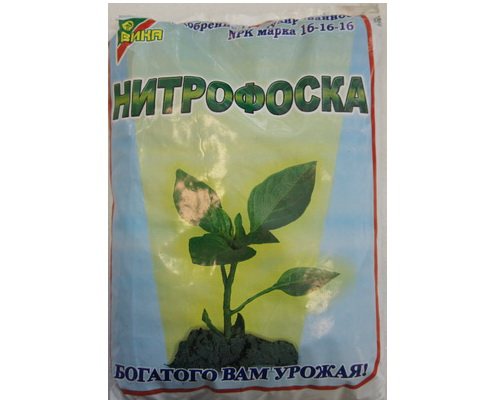

Nitrofoska fertilizer: application
Contents of step-by-step instructions:
Three elements are the basis of plant life
The classic "trinity" - nitrogen, phosphorus, potassium - substances that are absolutely essential for the plant. Without them, seedlings will not grow, leaves, stems, trunks and branches will not form, flower buds will not be tied, fruits will not ripen. At each stage of development, the plant needs elements from this trio to varying degrees. For leaf and stem mass, nitrogen is needed. Potassium will contribute to flowering. And phosphorus will increase the yield.
Three elements are the "skeletal basis" of nitrophoska fertilizer. They form a universal complex, which, in different versions, is applicable to all plants in any climate and on any land. The fertilizer formula is abbreviated as NPK. Despite the fact that there are only three elements in the formula, the drug includes many more components.


Nitrophoska contains nitrogen, phosphorus, potassium
The components are included in it in the form of various salt compounds:
- ammonium nitrate;
- superphosphate;
- ammonium chloride;
- potassium nitrate;
- ammophos;
- calcium chloride;
- precipitate.
Plus there is gypsum flour and ballast substances.
Some amateur vegetable growers who do not trust chemicals are beginning to worry when they see the name of the fertilizer as a single root word with nitrates. That's right, the components are contained in the preparation, including in the nitrate form. This means that after applying top dressing, nitrates can linger in the plant and accumulate there. Harm to health can be avoided if you use the top dressing only in the dosage recommended by the instructions. And, by the way, it is possible to "nourish" the plant with nitrates even with excessive use of manure and other animal organics.

